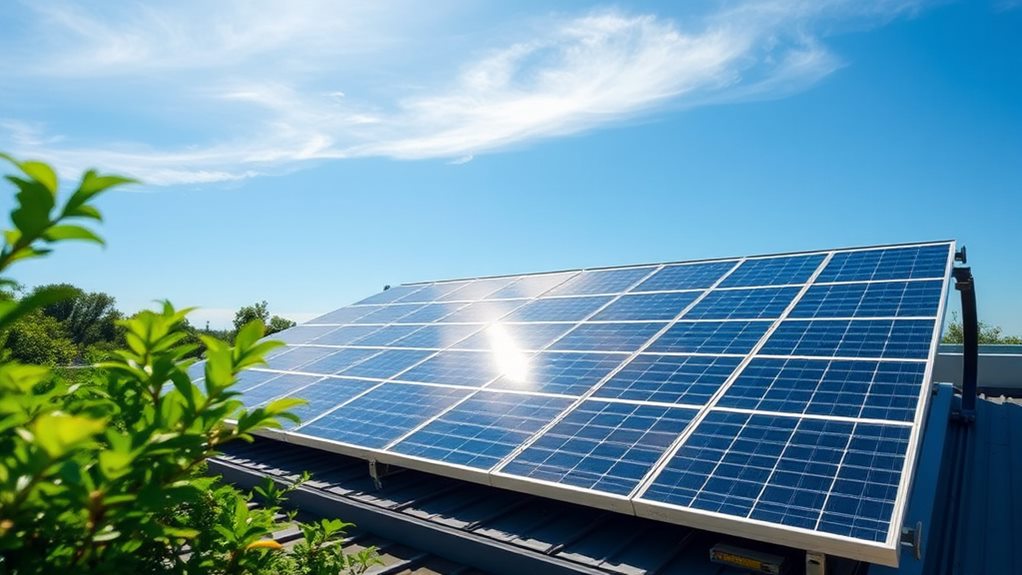You should take advantage of 2023 solar panel rebates to greatly reduce your installation costs. For instance, the Federal Investment Tax Credit allows you to deduct 30% of your system's cost from your federal taxes, potentially saving you around $3,429 on a $24,000 installation. Additionally, local incentives, such as rebates from Austin Energy and AEP Texas, further enhance affordability. With a typical payback period of just 6 to 12 years, the long-term financial benefits are substantial. Exploring these options fully can maximize your savings and provide a clear pathway to energy independence. Discover the available incentives that might fit your needs.
Overview of Solar Panel Rebates

In 2023, homeowners in Texas can take advantage of various solar panel rebates that greatly reduce installation costs. Local solar incentives, such as Austin Energy's $2,500 rebate and AEP Texas's rebate of up to $3,000 for residential photovoltaic (PV) systems, play an essential role in making solar energy accessible.
With the increasing popularity of solar energy, many homeowners benefit from the reduced electricity bills and increased property value associated with solar panel installation, as highlighted in the benefits of solar panels. The City of Sunset Valley even offers a rebate of $1.00 per watt, capped at $3,000, encouraging more homeowners to contemplate installing solar panels.
Furthermore, the federal solar tax credit, known as the Investment Tax Credit (ITC), allows energy customers to deduct 30% of their installation costs from their federal taxes. This federal incentive can greatly enhance the financial benefits of local rebates, resulting in substantial savings.
It's essential to acknowledge that many local rebate programs are designed to complement the absence of statewide incentives, thereby providing additional support for Texas homeowners.
Key Federal Tax Incentives
One of the most significant advantages for homeowners contemplating solar panel installation is the Federal Investment Tax Credit (ITC). This tax credit for solar offers a substantial 30% deduction on your federal income tax liability through 2033, making it an invaluable financial benefit for those looking to invest in residential solar.
Not only does this tax incentive help offset initial costs, but it also makes shifting to a money-saving energy source more appealing. This means you can deduct 30% of the total costs associated with installing solar panels, including equipment, labor, and permitting fees, maximizing your savings.
It's important to note that the ITC is nonrefundable; it reduces the tax you owe but doesn't provide a cash refund. However, any unused credits can be carried forward to future tax years, allowing flexibility in how you can utilize your clean energy tax credits.
With the ITC set to decrease to 26% in 2024 and 22% in 2025, the urgency to take advantage of these incentives available in 2023 is clear.
Furthermore, you can claim the solar tax credit for multiple installations across different years, potentially increasing your cumulative savings over time. This makes now the perfect time to evaluate your options for installing solar and benefiting from these energy credits.
Local Incentives and Rebates

Local incentives and rebates can make a considerable difference in the cost of installing solar panels for your home. In Texas, there are over 25 local rebate programs designed to provide financial incentives that considerably reduce your upfront costs for solar installations.
For instance, Austin Energy offers a rebate of $2,500 for residential solar systems, but you must complete an educational course on solar energy to qualify. Additionally, AEP Texas provides rebates of up to $3,000 for residential photovoltaic (PV) systems, promoting the adoption of solar technology among homeowners.
With California leading the U.S. in solar energy adoption, similar programs in Los Angeles can also help residents benefit from energy-saving solutions.
The City of Sunset Valley also offers a rebate program that gives you $1.00 per watt, with a maximum rebate of $3,000 for residential solar installations.
Denton Municipal Electric stands out with substantial rebates of up to $30,000 or 50% of installation costs for qualifying solar panel installations, enhancing the financial appeal of solar energy.
These local incentives, supported by the Texas Solar Rights Law, create a robust environment for homeowners considering solar panel installation. By taking advantage of these rebate programs, you can considerably lower your investment in renewable energy and contribute to a sustainable future.
Utility-Specific Programs
Utility-specific programs can greatly enhance the financial benefits of going solar. Many utilities offer incentives that can notably reduce your costs. For instance, AEP Texas provides rebates of up to $3,000 for residential solar PV systems, making it easier for homeowners to adopt solar energy.
If you've installed your solar panels, CPS Energy reimburses you for surplus energy at avoided cost rates, ensuring you profit from excess generation. Additionally, Texas utilities like Austin Energy have developed the Value of Solar program, which grants bill credits for surplus energy produced, currently set at 9.91 cents per kWh for systems under 1MW.
Local solar incentives can further increase affordability for residents looking to go green.
Moreover, the City of Brenham's Electric Tariff Program supports net metering, compensating homeowners for the energy they contribute to the grid. Local rebate programs, such as those offered by Denton Municipal Electric, can cover up to 50% of installation costs or provide up to $30,000, making solar installations more affordable for residents.
Long-Term Financial Benefits

How can investing in solar panels transform your long-term financial outlook? By taking advantage of 2023 solar panel rebates, you can greatly lower your upfront installation costs. For example, Texas offers local rebates up to $3,000 for residential systems, making new solar panels more affordable.
Additionally, the Federal Investment Tax Credit (ITC) allows you to deduct 30% of your installation costs from your federal taxes, providing an estimated average savings of $3,429 on a $24,000 system.
Moreover, installing solar panels in Texas comes with advantageous property tax exemptions, resulting in an average annual savings of around $353. You can also benefit from net metering programs, which allow you to earn credits for excess energy produced, directly reducing your future electricity bills.
With an average payback period of 6 to 12 years for solar systems in Texas, the financial benefits compound over time, especially when combined with state incentives and utility rebates.
Ultimately, investing in solar panels not only enhances your energy savings but also contributes to a more sustainable financial future. By embracing these opportunities, you'll position yourself for long-term financial success.
Final Thoughts
To sum up, taking advantage of the 2023 solar panel rebates can greatly reduce your upfront costs and enhance your long-term savings. For instance, homeowners can save an average of $9,000 over 20 years by utilizing federal and local incentives. By investing in solar energy now, you not only contribute to a sustainable future but also enjoy substantial financial benefits. Don't miss out on these opportunities to make a wise investment in both your wallet and the environment.


Recent Comments